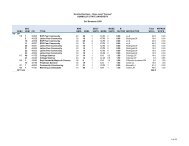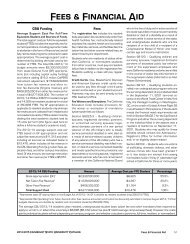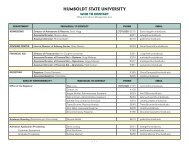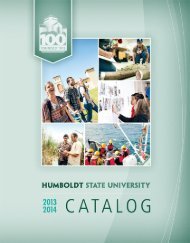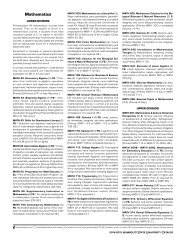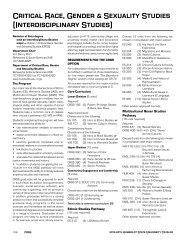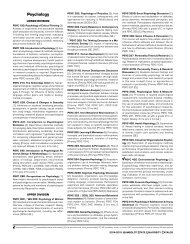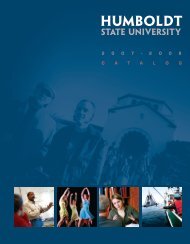2011-12 Academic Year - Bad Request - Humboldt State University
2011-12 Academic Year - Bad Request - Humboldt State University
2011-12 Academic Year - Bad Request - Humboldt State University
You also want an ePaper? Increase the reach of your titles
YUMPU automatically turns print PDFs into web optimized ePapers that Google loves.
Appropriate Technology Minor<br />
Minor in Appropriate Technology<br />
Advisors:<br />
Arne Jacobson, Ph.D.<br />
Department of Environmental<br />
Resources Engineering<br />
Harry Griffith Hall 116B<br />
707-826-3184<br />
John Meyer, Ph.D.<br />
Department of Politics<br />
Founders Hall 138<br />
707-826-4497<br />
The Program<br />
The term “appropriate technology” challenges<br />
the presumed inevitability or naturalness<br />
of technological development. At the same<br />
time, the question of which technologies are<br />
Art<br />
Bachelor of Arts degree<br />
with a major in Art —<br />
concentrations in art history<br />
and art studio<br />
Minor in Art History<br />
Minor in Art Studio<br />
Certificate of Study in<br />
Art Museum & Gallery Practices<br />
(see Certificates of Study)<br />
The Art Department is a fully accredited<br />
member of the National Association of<br />
Schools of Art and Design.<br />
Department Chair<br />
Teresa Stanley<br />
Department of Art<br />
Art Complex <strong>12</strong>1<br />
707-826-3624<br />
www.humboldt.edu/art<br />
REQUIREMENT FOR THE MAJOR<br />
Students must receive a minimum grade<br />
of C- in any major course for it to count<br />
toward the major.<br />
<strong>2011</strong>-20<strong>12</strong> <strong>Humboldt</strong> <strong>State</strong> <strong>University</strong> Catalog<br />
“appropriate” resists easy or predetermined<br />
answers. An HSU minor in appropriate<br />
technology allows students to familiarize<br />
themselves with promising technologies,<br />
while also developing their understanding of<br />
the political, social, and economic processes<br />
by which choices about technologies are<br />
-- and might be -- made.<br />
Courses enable students to combine theory<br />
and practice, often through hands-on projects<br />
at the Campus Center for Appropriate<br />
Technology (CCAT). CCAT is student-run, living<br />
laboratory and demonstration home on<br />
the HSU campus. It models effective energy<br />
use, a photovoltaic electrical system, solar<br />
hot water heating, graywater recycling, a<br />
composting privy, organic gardening, lowimpact<br />
building materials, and many other<br />
technologies, in a residential setting.<br />
ART HISTORY CONCENTRATION<br />
The Program<br />
Students completing this program will have<br />
demonstrated:<br />
recognition of art from a diverse number<br />
of periods, cultures, and civilizations<br />
experience with the materials and working<br />
methods of artists<br />
study of at least one foreign language<br />
the ability to find information in the library<br />
using both traditional and online resources<br />
recognition of different methods of interpretation<br />
use of the vocabulary and language of<br />
visual analysis<br />
the relationship of art to other disciplines<br />
in the humanities, social sciences, or sciences<br />
oral presentation of information and<br />
ideas to a group<br />
written presentation of information and<br />
ideas in a formal research paper.<br />
At <strong>Humboldt</strong>, art history is taught in a variety<br />
of ways, based on the visual and historical<br />
contexts in which the art was created. At the<br />
The minor can be of particular value to students<br />
wishing to pursue careers in science,<br />
public policymaking, or community development.<br />
It can also be useful for students<br />
wishing to volunteer for the Peace Corps<br />
or other overseas development work. For<br />
those wishing to design and develop technological<br />
systems professionally, the minor<br />
is not an adequate substitute for a major<br />
in Environmental Resource Engineering,<br />
Applied Technology, or a related field.<br />
REQUIREMENTS FOR THE MINOR<br />
ENGR 114 Whole Earth Engineering<br />
ENGR 305 Appropriate Technology<br />
ENGR 308 Technology & the<br />
Environment<br />
PSCI 373 Politics of Sustainable<br />
Society<br />
PSCI 464 Technology & Development<br />
SOC 320 Social Ecology<br />
n n n<br />
beginning level of instruc tion, the program<br />
features period courses (ART 104), such as<br />
Renaissance Art and 20th Century Art. These<br />
cours es introduce works of art within their<br />
historical contexts.<br />
Upper division courses focus on narrow er<br />
periods, movements, artists, or problems,<br />
such as 20th Century Women Artists and<br />
Vincent Van Gogh.<br />
The undergraduate seminar provides a<br />
capstone experience preparing students<br />
for advanced study leading to teaching and<br />
curatorial careers.<br />
Besides courses in art history, students<br />
enroll in at least two studio art courses to<br />
familiarize themselves with materials and<br />
creative working methods of artists. Study of<br />
gallery and museum methods gives students<br />
both theoretical and practical experience<br />
in the important areas of art display and<br />
management. This can lead to careers in<br />
the gallery and museum world. Students also<br />
complete a year of language study to learn<br />
how language affects thinking and visual<br />
experience in other cultures.<br />
Art<br />
77







